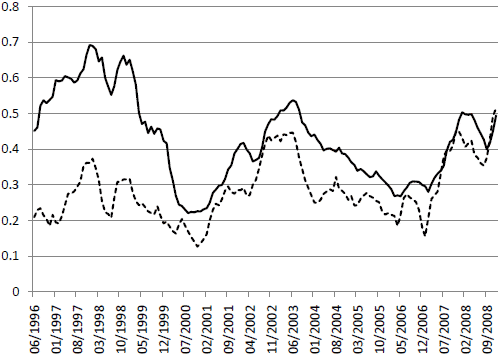How exposed are hedge funds to “rogue” correlations, wherein returns of assets or asset classes that normally exhibit hedging cancellation instead exhibit hedge-killing reinforcement? In the June 2010 version of their paper entitled “‘When There Is No Place to Hide’: Correlation Risk and the Cross-Section of Hedge Fund Returns”, Andrea Buraschi, Robert Kosowski and Fabio Trojani investigate the exposure of hedge funds to correlation risk (risk of unexpected changes in the correlation between the returns of different assets or asset classes) and the implications of this risk for hedge fund returns. Using data for actual one-month-to-maturity S&P 500 correlation swaps (based on daily implied versus realized correlation), individual S&P 500 stock and index put and call options and a broad sample of 8,710 individual hedge funds spanning in combination January 1996 through December 2008, they find that:
- Rogue correlations tend to occur during market crashes or periods of economic crisis.
- The correlation risk premium over the entire sample period averages -14.3% per month, but declines over time (see the chart below). The bulk of the option-implied variance risk premium apparently derives from correlation risk.
- Because they seek to exploit correlation to dampen aggregate return volatility, hedge funds generally impound correlation risk. Adjusting for correlation risk (after adjusting for seven other commonly used hedge fund risk factors) reduces the alpha of a broad value-weighted hedge fund index from 5.36% to 3.47%.
- Correlation risk exposures are particularly high for Long/Short Equity, Option Trader, Merger Arbitrage and Multi-Strategy hedge funds. Adjusting for correlation risk (after adjusting for the seven other factors) reduces the alpha of a value-weighted index of these low net market exposure funds from 13.7% to 4.25%.
- Adding a correlation risk factor to a seven-factor hedge fund return model increases the model’s ability to explain hedge fund returns from 10.5% to 17.7%.
- Funds with large negative correlation risk exposures tend to have high returns. The tenth of hedge funds with the most negative correlation risk exposures (implicitly selling insurance against unexpected increases in correlations) have an average raw annualized return of 13.4% and a seven-factor alpha of 8.9%. However, correlation risk explains over 10% of the 13.4% return.
- Correlation risk exposure strongly affects hedge fund return distribution tail behavior and maximum drawdown. The typical maximum drawdown for the tenth of hedge funds with the largest negative correlation risk exposures are nearly three times bigger than the typical drawdown of the tenth of funds with the largest positive correlation risk exposure.
- Results are robust to use of alternative databases, equal weighting instead of value weighting and inclusion of liquidity factors.

In summary, evidence indicates that hedge funds with low net market exposure may earn returns largely by assuming that correlations between assets and asset classes will behave predictably, and rogue correlation spikes may swamp these funds with extremely large drawdowns.

No comments:
Post a Comment